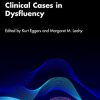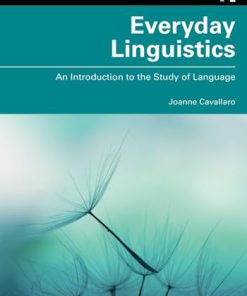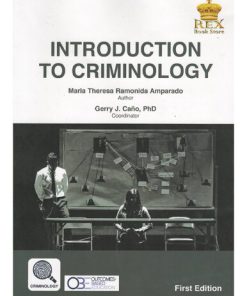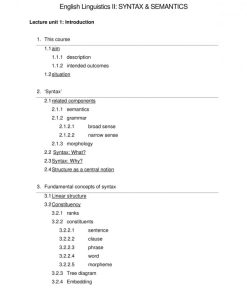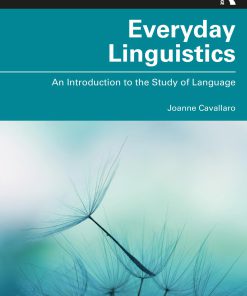Introduction to English Linguistics 3rd Edition by Ingo Plag, Sabine Arndt Lappe, Maria Braun, Mareile Schramm ISBN 3110376180 9783110376180
$50.00 Original price was: $50.00.$25.00Current price is: $25.00.
Introduction to English Linguistics 3rd Edition by Ingo Plag, Sabine Arndt Lappe, Maria Braun, Mareile Schramm – Ebook PDF Instant Download/Delivery: 3110376180 ,9783110376180
Full download Introduction to English Linguistics 3rd Edition after payment

Product details:
ISBN 10: 3110376180
ISBN 13: 9783110376180
Author: Ingo Plag, Sabine Arndt Lappe, Maria Braun, Mareile Schramm
Introduction to English Linguistics 3rd Edition Table of contents:
1 The sounds: phonetics
1.1 Introduction
1.2 Spelling vs. pronunciation: the representation of speech sounds
1.3 Producing sounds
1.3.1 The nature of speech sounds
1.3.2 The vocal tract
1.4 How sounds differ from each other: the classification of speech sounds
1.4.1 The classification of consonants
1.4.2 The classification of vowels
1.5 Conclusion
Further reading
Exercises
2 The sound system: phonology
2.1 Introduction
2.2 Introducing order into the chaos: the phoneme
2.3 The key to finding the order
2.3.1 Minimal pairs
2.3.2 Distributional characteristics of allophones
2.3.3 Observing allophonic alternations in different word forms
2.4 More about the sound system of English
2.4.1 Allophones of /l/
2.4.2 Stop phonemes
2.4.3 A slightly more complex case: /ɹ/
2.5 The syllable
2.5.1 The structure of the syllable
2.5.2 Syllabification
2.5.3 The syllable and allophonic processes: /l/ revisited
2.6 Conclusion
Further reading
Exercises
3 The structure of words: morphology
3.1 Introduction
3.2 Minimal building blocks: morphemes
3.3 Types of morphemes
3.4 Morphological analysis of words
3.5 Realisation of morphemes: allomorphs
3.6 Morphological processes: inflection and derivation
3.7 Word-formation
3.7.1 What is word-formation?
3.7.2 Affixation
3.7.3 Compounding
3.7.4 Conversion
3.7.5 Shortening
3.8 Conclusion
Further reading
Exercises
4 The structure of sentences: syntax
4.1 Introduction: rules and grammar
4.2 The building blocks: words and phrases
4.2.1 Constituency tests and phrases
4.2.2 The internal structure of phrases
4.3 The functional level: subjects, objects, adverbials, predicates, complements
4.4 The mapping of form and function
4.5 Conclusion
Further reading
Exercises
5 The meaning of words and sentences: semantics
5.1 Introduction
5.2 What does ‘meaning’ mean? Words, concepts and referents
5.3 Compositional and non-compositional meaning
5.4 The network: organising word meaning
5.4.1 Words and other words
5.4.2 Same or different?
5.5 Conclusion
Further reading
Exercises
6 Studying language in use: pragmatics
6.1 Introduction
6.2 Expressing intentions through language
6.2.1 Using language to act: speech acts
6.2.2 Speech acts: a closer look
6.2.3 Classifying speech acts
6.2.4 Realisations of speech acts: direct and indirect speech acts
6.2.5 Performing speech acts successfully: felicity conditions
6.3 Understanding utterance meaning
6.4 Exploring pragmatic principles
6.4.1 The Cooperative Principle
6.4.2 Politeness
6.5 Conclusion
Further reading
Exercises
7 Extensions and applications: historical linguistics, sociolinguistics and psycholinguistics
7.1 Introduction
7.2 Historical linguistics: how languages develop
7.3 Sociolinguistics: the social significance of language
7.4 Psycholinguistics: how do we store and process language?
7.5 Conclusion
Further reading
Exercises
8 Linguistics as an empirical science
8.1 Introduction
8.2 How to do empirical research in linguistics
8.3 A corpus-based study in morphology: who or whom, that is the question
8.4 An experimental study in syntax: the dative alternation
8.5 Conclusion
Further reading
Exercises
Glossary
People also search for Introduction to English Linguistics 3rd Edition:
5 sentence introduction paragraph
introduction to linguistic 3rd year
introduction to linguistics lesson 1
introduction to linguistics phonology
introducing linguistics
Tags: Ingo Plag, Sabine Arndt Lappe, Maria Braun, Mareile Schramm, English Linguistics
You may also like…
Linguistics - Linguistics
Why Do Linguistics?: Reflective Linguistics and the Study of Language 2nd Edition Fiona English
Linguistics - Linguistics
Everyday Linguistics : An Introduction to the Study of Language 1st Edition Joanne Cavallaro
Linguistics - Linguistics
English Corpus Linguistics An Introduction 2nd Edition Charles F. Meyer
Linguistics - Linguistics
Uncategorized
dictionaries & phrasebooks
Linguistics - Linguistics
Everyday Linguistics: An Introduction to the Study of Language 1st Edition Joanne Cavallaro

